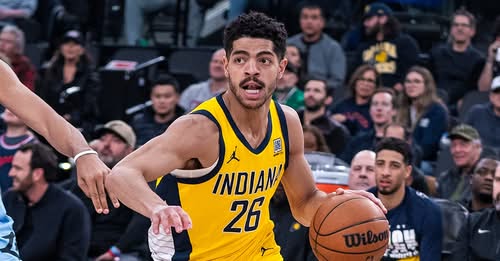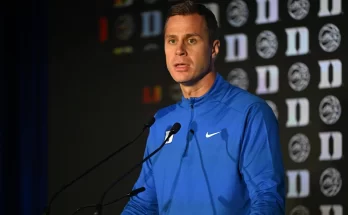Over the last two seasons, the Indiana Pacers have boasted one of the deepest teams in the NBA, a trait that has allowed them to not only withstand injuries but also compete with the top teams in the Eastern Conference. The Pacers have been quietly building a roster filled with versatility, balance, and a unique mix of veterans and young players capable of contributing in different ways. One of the prime examples of this roster depth and development is the emergence of wing Ben Sheppard. Coming into the league, Sheppard was seen as a player who would need some time to adjust, but his rapid growth and consistent improvement have made him one of Indiana’s most valuable pieces. After a standout rookie season that caught many by surprise, Sheppard continued to grow in his sophomore campaign, showing why he may be one of the key long-term fixtures for the franchise.
Sheppard entered the NBA without the hype of a lottery pick, but his college career and skill set indicated that he had the tools to succeed in the league if given the right opportunity. Indiana proved to be the perfect landing spot. With a team that prioritizes ball movement, defense, and shooting, Sheppard’s all-around game fit seamlessly. In his rookie season, he displayed a level of composure and basketball IQ that is not always common for first-year players. He carved out minutes by playing hard-nosed defense on the perimeter, knocking down open shots, and never shying away from the dirty work. His energy off the bench often sparked runs for Indiana, and his ability to impact games without necessarily having the ball in his hands stood out. By the end of his rookie year, Sheppard was no longer seen as just a developmental piece but as a reliable contributor in Rick Carlisle’s rotation.
As his sophomore season began, expectations shifted. Instead of merely surviving, Sheppard was expected to thrive, and he rose to the challenge. With increased minutes and a more prominent role, he showcased growth in multiple areas. His shooting efficiency improved, his handle looked tighter, and he became more confident in creating his own shot rather than only relying on catch-and-shoot opportunities. On defense, his anticipation and footwork allowed him to take on tougher assignments, often being trusted to guard some of the league’s best wings. That trust from the coaching staff highlighted how far he had come in a short time, evolving from a rookie who needed to prove he belonged into a young player who could be relied upon in critical moments.
The Pacers’ system has been instrumental in Sheppard’s rise. Surrounded by playmakers such as Tyrese Haliburton, Pascal Siakam, and Bennedict Mathurin, Sheppard benefits from being in an offense that thrives on spacing and ball movement. He has taken advantage of open looks generated by his teammates, but what has been most impressive is how he has expanded his game beyond being a spot-up shooter. More and more, he has attacked closeouts, finished at the rim, and even initiated secondary plays. This added dimension to his game not only makes him harder to defend but also makes the Pacers more dynamic. When Sheppard is on the floor, Indiana often finds another gear, able to push the pace and force defenses into difficult rotations.
Another element of Sheppard’s development has been his confidence. In his rookie season, he sometimes hesitated to take shots, especially in late-game scenarios. But in year two, that hesitation disappeared. He began to embrace moments when the ball swung to him with the shot clock winding down or when Indiana needed someone to step up. That shift in mentality is often what separates role players from long-term starters, and while Sheppard may still be carving out his exact role for the future, his trajectory suggests he could be much more than just a complementary piece.
The Pacers’ depth has made their roster one of the most talked about in the league, but players like Sheppard are what truly make that depth impactful. Depth is not just about having names on the bench; it is about having players who can seamlessly step into bigger roles when needed without a significant drop-off. Sheppard embodies that. Whenever injuries occurred or when lineups needed to be shuffled, he was the type of player who filled the gaps. His versatility allowed him to play multiple positions on the wing, defend guards or forwards, and adapt to different lineups. That flexibility gave Carlisle options that many coaches in the league would envy.
Sheppard’s emergence also speaks to Indiana’s organizational philosophy. The Pacers have long been known as a franchise that values player development and character as much as raw talent. From the front office to the coaching staff, there is a clear emphasis on giving young players opportunities to grow, and Sheppard is a product of that culture. Instead of being buried on the bench or rushed into a role he wasn’t ready for, he was gradually given more responsibility as his game expanded. This careful balance between patience and trust has paid off, and now the Pacers look like they have uncovered another gem to add to their promising core.
Looking at Sheppard’s skill set, it is not hard to see why he fits so well in today’s NBA. Wings who can defend multiple positions, shoot at a high percentage, and move without the ball are invaluable. He does not need plays run for him to be effective, yet he can still swing the momentum of a game with his contributions. For Indiana, that makes him an ideal piece alongside stars like Haliburton and Siakam. He does not take touches away from the team’s offensive engines, but he enhances their play by knocking down shots when defenses collapse and by defending at a level that helps mask some of the team’s weaknesses.
One of the most encouraging aspects of Sheppard’s second season was his improvement in consistency. It is one thing for a young player to flash potential with sporadic standout games, but sustaining production over the course of a season is what sets players apart. Sheppard’s numbers may not always leap off the stat sheet, but his steady contributions night after night became a backbone for Indiana’s second unit and sometimes even the starting lineup when matchups dictated. He rarely had stretches where he disappeared, and that type of reliability is exactly what coaches covet.
As Indiana looks ahead, Sheppard’s role could continue to expand. The Pacers are building a team with aspirations beyond simply making the playoffs; they want to be contenders. For that to happen, they will need more than just their stars—they will need players like Sheppard to keep developing into trusted contributors who can thrive in high-pressure situations. If his trajectory continues, it is not unreasonable to think he could eventually start on a contending team or at least be a critical sixth man who plays starter-level minutes.
The growth of Sheppard also impacts how the Pacers build their roster moving forward. Having a young, versatile wing on a rookie-scale contract gives Indiana financial flexibility and roster stability. It allows them to invest resources elsewhere while knowing they have someone who can step into a bigger role if needed. In a league where wings are at a premium, finding one who can impact winning without requiring a massive salary is a significant advantage.
Sheppard’s journey from promising rookie to reliable sophomore contributor has also made him a fan favorite. Pacers fans, who have long appreciated blue-collar, hardworking players, see in Sheppard someone who embodies that ethos. He may not have the flashiest game, but his effort, intelligence, and willingness to do whatever it takes to help the team win resonate with the fan base. Over time, that connection between player and city often grows into something special, and Indiana seems to have another homegrown favorite in the making.
The story of Ben Sheppard is still being written, but the first two chapters have been highly promising. He came into the NBA as an under-the-radar prospect, carved out a role with defense and energy, and then expanded his game in his sophomore season to become a more complete player. With each passing month, he has added layers to his skill set and shown a maturity that belies his age. If he continues on this path, he could be one of the defining players of Indiana’s next era of basketball.
For the Pacers, his emergence is another sign that their commitment to depth and development is paying off. In a league dominated by stars, Indiana is proving that building a complete roster matters just as much. Sheppard may not be the headliner on a team with All-Stars like Haliburton and Siakam, but he represents the type of player every great team needs—the one who fills the gaps, steps up when called upon, and makes winning plays that do not always show up in the box score. As the Pacers continue their climb in the Eastern Conference, Ben Sheppard’s growth will remain a key storyline, a testament to both his hard work and the team’s vision.
The NBA is a league of constant evolution, and players who adapt are the ones who last. Ben Sheppard has already shown he can evolve, adding to his game and adjusting to new responsibilities year after year. That adaptability, combined with his work ethic and natural feel for the game, suggests his ceiling may be higher than many initially thought. Indiana has found themselves not just a role player, but potentially a cornerstone of their depth and culture moving forward. For now, he remains one of the league’s most intriguing young wings, and his story is one that Pacers fans will be watching closely for years to come.



